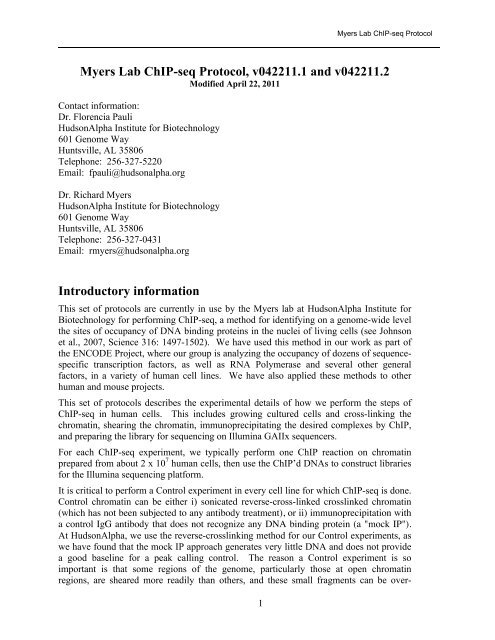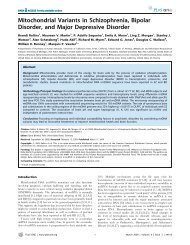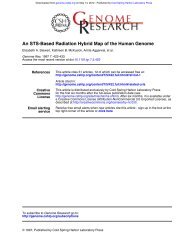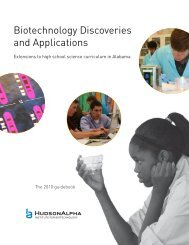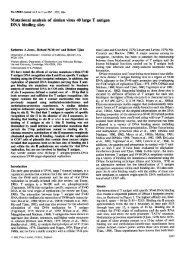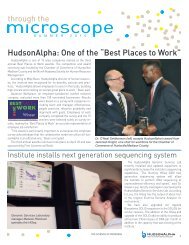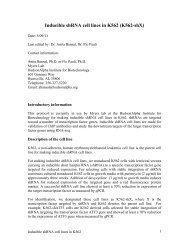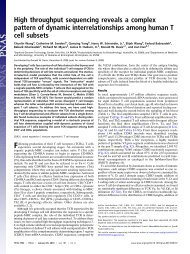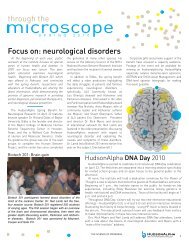Myers Lab ChIP-seq Protocol v042211_FPedits
Myers Lab ChIP-seq Protocol v042211_FPedits
Myers Lab ChIP-seq Protocol v042211_FPedits
Create successful ePaper yourself
Turn your PDF publications into a flip-book with our unique Google optimized e-Paper software.
1<br />
<strong>Myers</strong> <strong>Lab</strong> <strong>ChIP</strong>-<strong>seq</strong> <strong>Protocol</strong><br />
<strong>Myers</strong> <strong>Lab</strong> <strong>ChIP</strong>-<strong>seq</strong> <strong>Protocol</strong>, <strong>v042211</strong>.1 and <strong>v042211</strong>.2<br />
Modified April 22, 2011<br />
Contact information:<br />
Dr. Florencia Pauli<br />
HudsonAlpha Institute for Biotechnology<br />
601 Genome Way<br />
Huntsville, AL 35806<br />
Telephone: 256-327-5220<br />
Email: fpauli@hudsonalpha.org<br />
Dr. Richard <strong>Myers</strong><br />
HudsonAlpha Institute for Biotechnology<br />
601 Genome Way<br />
Huntsville, AL 35806<br />
Telephone: 256-327-0431<br />
Email: rmyers@hudsonalpha.org<br />
Introductory information<br />
This set of protocols are currently in use by the <strong>Myers</strong> lab at HudsonAlpha Institute for<br />
Biotechnology for performing <strong>ChIP</strong>-<strong>seq</strong>, a method for identifying on a genome-wide level<br />
the sites of occupancy of DNA binding proteins in the nuclei of living cells (see Johnson<br />
et al., 2007, Science 316: 1497-1502). We have used this method in our work as part of<br />
the ENCODE Project, where our group is analyzing the occupancy of dozens of <strong>seq</strong>uencespecific<br />
transcription factors, as well as RNA Polymerase and several other general<br />
factors, in a variety of human cell lines. We have also applied these methods to other<br />
human and mouse projects.<br />
This set of protocols describes the experimental details of how we perform the steps of<br />
<strong>ChIP</strong>-<strong>seq</strong> in human cells. This includes growing cultured cells and cross-linking the<br />
chromatin, shearing the chromatin, immunoprecipitating the desired complexes by <strong>ChIP</strong>,<br />
and preparing the library for <strong>seq</strong>uencing on Illumina GAIIx <strong>seq</strong>uencers.<br />
For each <strong>ChIP</strong>-<strong>seq</strong> experiment, we typically perform one <strong>ChIP</strong> reaction on chromatin<br />
prepared from about 2 x 10 7 human cells, then use the <strong>ChIP</strong>’d DNAs to construct libraries<br />
for the Illumina <strong>seq</strong>uencing platform.<br />
It is critical to perform a Control experiment in every cell line for which <strong>ChIP</strong>-<strong>seq</strong> is done.<br />
Control chromatin can be either i) sonicated reverse-cross-linked crosslinked chromatin<br />
(which has not been subjected to any antibody treatment), or ii) immunoprecipitation with<br />
a control IgG antibody that does not recognize any DNA binding protein (a "mock IP").<br />
At HudsonAlpha, we use the reverse-crosslinking method for our Control experiments, as<br />
we have found that the mock IP approach generates very little DNA and does not provide<br />
a good baseline for a peak calling control. The reason a Control experiment is so<br />
important is that some regions of the genome, particularly those at open chromatin<br />
regions, are sheared more readily than others, and these small fragments can be over-
2<br />
<strong>Myers</strong> <strong>Lab</strong> <strong>ChIP</strong>-<strong>seq</strong> <strong>Protocol</strong><br />
represented in the <strong>seq</strong>uencing step, giving the false conclusion that these regions are sites<br />
of occupancy. By performing the reverse-crosslink Control separately from the antibody<br />
<strong>ChIP</strong> experiments, these false signals can be subtracted on a region-by-region basis.<br />
Indeed, the peak-calling algorithms for <strong>ChIP</strong>-<strong>seq</strong> take this issue into account.<br />
In the following pages, we describe each of the steps for preparing samples for <strong>seq</strong>uencing<br />
in <strong>ChIP</strong>-<strong>seq</strong>. This protocol differs from our previous protocols in that the incubation times<br />
for <strong>ChIP</strong> have been reduced from overnight to 2 hours, a Bioruptor Twin (Diagenode) was<br />
used for chromatin sonication and fragment size selection for <strong>seq</strong>uencing library<br />
construction was done using Agencourt Ampure XP beads.
I. Growth of cells<br />
3<br />
<strong>Myers</strong> <strong>Lab</strong> <strong>ChIP</strong>-<strong>seq</strong> <strong>Protocol</strong><br />
Note: <strong>ChIP</strong> works best when cells are healthy and in “log phase” growth. Do not grow<br />
suspension cells to maximum density or to high acidity, and, for adherent cells, do not<br />
grow cells to confluency.<br />
A. Suspension cells (for example, K562, Jurkat, GM06990)<br />
1. Grow cells to log phase growth (10 6 cells/ml maximum density).<br />
2. Count cells and measure viability by staining an aliquot of the cells with trypan blue.<br />
If viability, as measured by exclusion of the blue dye, is >90%, proceed to the next<br />
steps. If viability is lower, discard the experiment and start over with new cells.<br />
B. Adherent cells (for example, HepG2, HCT-116)<br />
It is easier to process adherent cells growing on tissue culture plates rather than in flasks.<br />
1. Prepare an additional plate for counting. Grow cells to a final cell density of 2-5 x 10 7<br />
per 150-mm dish.<br />
2. Trypsinize one tissue culture plate. Count and test for viability by removing a small<br />
aliquot and staining with trypan blue.<br />
If viability, as measured by exclusion of the blue dye, is >90%, proceed to the next<br />
steps. If viability is lower, discard the experiment and start over with new cells.
II. Cross-linking of chromatin, harvest, and storage<br />
4<br />
<strong>Myers</strong> <strong>Lab</strong> <strong>ChIP</strong>-<strong>seq</strong> <strong>Protocol</strong><br />
Note: Suspension and adherent cells are cross-linked and collected differently. For ease<br />
of experimentation, we recommend harvesting in aliquots of 2 x 10 7 cells.<br />
Reagents:<br />
All reagents are at room temperature unless otherwise noted.<br />
20% formaldehyde [36.5% Formaldehyde for molecular biology Sigma F87750]<br />
2.5 M glycine<br />
1X PBS 4 o C<br />
Farnham Lysis buffer 4 o C 5 mM PIPES pH 8.0 / 85 mM KCl / 0.5% NP-40 (adherent<br />
cells) + Roche Protease Inhibitor Cocktail Tablet<br />
(Complete 11836145001 for 50 ml or mini tablets<br />
11836153001 for 10 ml)<br />
[Add protease inhibitor tablet just before use]<br />
A. Suspension cells<br />
1. Transfer cells and media from the tissue culture flasks into either 50-ml conical tubes<br />
or centrifuge bottles.<br />
2. Add formaldehyde to a final concentration of 1%, mix gently, and incubate at room<br />
temperature for 10 minutes.<br />
3. To stop the cross-linking reaction, add glycine to a final concentration of 0.125 M and<br />
mix gently.<br />
4. Pellet cells at 2,000 rpm for 5 minutes at 4 o C.<br />
5. Place cells on ice and remove supernatant. Add equal volume cold (4 o C) 1X PBS and<br />
gently resuspend cells, then centrifuge again.<br />
6. Carefully remove supernatant and either proceed to sonication step or snap-freeze in<br />
liquid nitrogen and store at -80°C or in liquid nitrogen.<br />
Note: Frozen cross-linked cells appear to be stable indefinitely. Therefore, this is a<br />
convenient step in the protocol to collect many samples for testing multiple antibodies,<br />
biological replicates, controls, etc.
B. Adherent cells<br />
5<br />
<strong>Myers</strong> <strong>Lab</strong> <strong>ChIP</strong>-<strong>seq</strong> <strong>Protocol</strong><br />
1. To adherent cells growing on tissue culture plates, add formaldehyde directly to the<br />
media to a final concentration of 1%, swirl gently, and incubate at room temperature for<br />
10 minutes.<br />
2. Stop the cross-linking reaction by adding glycine to a final concentration of 0.125 M<br />
and swirl gently to mix.<br />
3. Remove media from plates and wash cells with equal volume cold (4 o C) 1X PBS.<br />
4. Aspirate PBS and add 5-8 ml cold (4 o C) Farnham lysis buffer + protease inhibitors.<br />
3. Scrape the cells off the plate with a cell scraper and transfer into 15-ml conical tubes on<br />
ice.<br />
4. Pellet cells at 2,000 rpm for 5 minutes at 4 o C.<br />
5. Place cells on ice. Carefully remove supernatant and either proceed to sonication step<br />
or snap-freeze in liquid nitrogen and store at -80°C or in liquid nitrogen.<br />
Note: Frozen cross-linked cells appear to be stable indefinitely. Therefore, this is a<br />
convenient step in the protocol to collect many samples for testing multiple antibodies,<br />
biological replicates, controls, etc.
III. Sonication<br />
6<br />
<strong>Myers</strong> <strong>Lab</strong> <strong>ChIP</strong>-<strong>seq</strong> <strong>Protocol</strong><br />
Note: The <strong>Myers</strong> lab has used three methods for sonicating chromatin. All of our<br />
experiments until Fall 2009 used a Sonics VibraCell sonicator, a relatively inexpensive<br />
approach that we fine-tuned to fragment the chromatin to a specific size range. After that<br />
time, we began using a Bioruptor sonicator, model XL, which is much easier (multiple<br />
samples can be sonicated at the same time) and cleaner (the samples are closed during the<br />
sonication treatment). Beginning in October of 2010, we began using a Bioruptor Twin<br />
(Diagenode) sonicator. All of the <strong>ChIP</strong>-<strong>seq</strong> datasets submitted to the ENCODE project<br />
and labeled as protocol <strong>v042211</strong>.1 or <strong>v042211</strong>.2 were done with the Bioruptor Twin. The<br />
reagents used are the same, but the methods differ. All methods are described below.<br />
Reagents:<br />
Farnham Lysis buffer: 5 mM PIPES pH 8.0 / 85 mM KCl / 0.5% NP-40 (filtered 0.2 -<br />
0.45 micron filter unit) + Roche Protease Inhibitor Cocktail<br />
(complete) 4 o C<br />
[Add protease inhibitor tablet just before use]<br />
RIPA Buffer: 1XPBS / 1% NP-40 / 0.5% sodium deoxycholate / 0.1% SDS<br />
(filtered 0.2 - 0.45 micron filter unit) + Roche Protease<br />
Inhibitor Cocktail 4 o C<br />
[Add protease inhibitor tablet just before use]<br />
Sonics VibraCell Sonicator:<br />
1. Resuspend each fresh or frozen pellet (containing 2 x 10 7 cells) on ice in 1 ml Farnham<br />
Lysis Buffer and mix gently by flicking the test tube.<br />
Note: This treatment breaks the cells while keeping the nuclei mostly intact. The<br />
Farnham lab includes a douncing step here to ensure that the cells are completely<br />
broken. We have found that douncing has not been necessary, but it is possible that it<br />
will increase yields and/or purity with some cell types.<br />
2. Collect the crude nuclear prep by centrifuging at 2,000 rpm at 4 o C for 5 minutes.<br />
3. Resuspend pellet to 1 ml with RIPA Buffer.<br />
Do not vortex the tubes and try to avoid bubbles. Bubbles will cause popping and loss<br />
of samples during sonication.<br />
4. Sonicate each 1.0 ml <strong>ChIP</strong> sample on ice, in a cold room, at Power Output 5 watts 6<br />
times for 30 seconds each, with at least 30 second cooling on ice between each 30-second<br />
sonication.<br />
Note: For <strong>ChIP</strong>Seq, it is critical that the average length of the sheared chromatin is<br />
about 250 bp or less, with a range of about 100-600 bp. If the average size range is
7<br />
<strong>Myers</strong> <strong>Lab</strong> <strong>ChIP</strong>-<strong>seq</strong> <strong>Protocol</strong><br />
much higher, there will be very little DNA in the portion of the gel from which the 100-<br />
250 bp fragments will be extracted.<br />
Important note: Our lab uses a Sonics VibraCell sonicator. Different sonicator<br />
models and even different individual sonicators of the same model may vary in the<br />
settings and conditions needed for fragmenting DNA to a particular size range. We<br />
strongly recommend that each group do a titration experiment with cross-linked<br />
chromatin to determine conditions for shearing to an average of 250 bp before<br />
attempting a <strong>ChIP</strong> experiment. See detailed discussion of sonication below.<br />
5. Spin the sonicated mixture at 14,000 rpm in a microfuge for 15 minutes at 4°C and<br />
collect the supernatant.<br />
6. Snap-freeze the sample in liquid nitrogen and store at -80°C, or do not freeze and<br />
continue with the immunoprecipitation steps below.<br />
Bioruptor (Diagenode, model XL) Sonicator:<br />
1. Resuspend each fresh or frozen pellet (containing 2x10 7 cells) on ice in 1 ml Farnham<br />
Lysis Buffer and mix gently by flicking the test tube.<br />
Note: This treatment breaks the cells while keeping the nuclei mostly intact. The<br />
Farnham lab includes a douncing step here to ensure that the cells are completely<br />
broken. We have found that douncing has not been necessary, but it is possible that it<br />
will increase yields and/or purity with some cell types.<br />
2. Collect the crude nuclear prep by centrifuging at 2,000 rpm at 4 o C for 5 minutes.<br />
3. Resuspend pellet to 300 µl with RIPA Buffer.<br />
4. Process samples in Bioruptor at high setting for a total time of 15 minutes, 30 seconds<br />
ON, 30 seconds OFF. The Bioruptor is connected to a re-circulating water chiller that<br />
maintains the water bath temperature at 4°C.<br />
Important note: Our lab uses a Diagenode XL Bioruptor. Different sonicator models and<br />
even different individual sonicators of the same model may vary in the settings and<br />
conditions needed for fragmenting DNA to a particular size range. We strongly<br />
recommend that each group do a titration experiment with cross-linked chromatin to<br />
determine conditions for shearing to an average of 250 bp before attempting a <strong>ChIP</strong><br />
experiment.<br />
5. Spin the sonicated mixture at 14,000 rpm in a microfuge for 15 minutes at 4°C and<br />
collect the supernatant.<br />
6. Bring the volume of the sonicated sample to 1 µl with RIPA buffer.
8<br />
<strong>Myers</strong> <strong>Lab</strong> <strong>ChIP</strong>-<strong>seq</strong> <strong>Protocol</strong><br />
7. Snap-freeze the sample in liquid nitrogen and store at -80°C, or do not freeze and<br />
continue with the immunoprecipitation steps below.<br />
Bioruptor (Diagenode, model Twin) Sonicator:<br />
1. Resuspend each fresh or frozen pellet (containing 2x10 7 cells) on ice in 1 ml Farnham<br />
Lysis Buffer and mix gently by flicking the test tube.<br />
Note: This treatment breaks the cells while keeping the nuclei mostly intact. Although<br />
we had found that a douncing step was not necessary when using the Vibracell or<br />
Bioruptor XL sonicators, we found that passing the lysate through a 20G needle 20<br />
times increased our yield when using the Bioruptor Twin. This step is optional and<br />
should be tested for each cell line.<br />
2. Collect the crude nuclear prep by centrifuging at 2,000 rpm at 4 o C for 5 minutes.<br />
3. Resuspend pellet to 300 µl with RIPA Buffer.<br />
4. Process samples in Bioruptor Twin with circulating water bath according to the<br />
manufacturer’s instructions for temperature (less than 4°C) and speed of circulation (
IV. Immunoprecipitation<br />
Reagents:<br />
All reagents are at room temperature unless otherwise noted.<br />
9<br />
<strong>Myers</strong> <strong>Lab</strong> <strong>ChIP</strong>-<strong>seq</strong> <strong>Protocol</strong><br />
Magnetic beads: Dynal / Invitrogen Dynalbeads (sheep anti-rabbit or anti-mouse<br />
IgG, or protein G)<br />
PBS/BSA: 1XPBS + 5 mg/ml BSA (fraction V) (freshly-prepared and<br />
filtered 0.2 - 0.45 micron filter unit) 4 o C + Roche Protease<br />
Inhibitor Cocktail<br />
[Add protease inhibitor tablet just before use]<br />
LiCl IP Wash Buffer: 100 mM Tris pH 7.5 / 500 mM LiCl / 1% NP-40 / 1% sodium<br />
deoxycholate (filtered 0.2 - 0.45 micron filter unit) 4 o C<br />
TE: 1X TE (10 mM Tris-HCl pH 7.5 + 0.1 mM Na2EDTA) 4 o C<br />
IP Elution Buffer: 1% SDS / 0.1 M NaHCO3 (filtered through 0.2 - 0.45 micron<br />
filter unit)<br />
1. Perform all steps in an ice bucket or in the cold room at 4°C. Couple the primary<br />
antibody for each transcription factor or chromatin protein to magnetic beads as follows:<br />
a. Add 200 µl re-suspended magnetic bead slurry to a 1.5 ml microfuge tube on ice<br />
containing 1 ml PBS/BSA. Vortex briefly to mix well.<br />
b. Place the microfuge tubes on the magnet and remove supernatants.<br />
c. Resuspend the beads in 1 ml PBS/BSA.<br />
d. Repeat Steps b and c 3 times.<br />
e. Add 1 ml PBS/BSA to beads.<br />
f. Add 5 µg primary antibody (25 µl 200 µg/ml from Santa Cruz).<br />
Do not vortex beads with bound antibody.<br />
g. Gently mix on a rotator platform for at least 2 hours at 4°C.<br />
h. Wash beads 3 times (steps b-c), resuspending the beads by inverting the tubes<br />
during each wash.<br />
i. Resuspend in 100 µl PBS/BSA, and proceed to Step 2.
10<br />
<strong>Myers</strong> <strong>Lab</strong> <strong>ChIP</strong>-<strong>seq</strong> <strong>Protocol</strong><br />
2. Add 100 µl of antibody-coupled beads (from step 1.i above) to each 1 ml chromatin<br />
preparation (from Sonication protocol) and incubate on a rotator for one hour at room<br />
temperature, followed by one hour at 4°C.<br />
3. Perform all steps in the cold room at 4°C. Collect beads containing immuno-bound<br />
chromatin by placing the microfuge tube on the magnet.<br />
4. Remove and discard supernatant.<br />
5. Wash beads 5 times with LiCl Wash Buffer, mixing 3 minutes for each wash on a<br />
rotator.<br />
6. Wash bead pellet with 1 ml TE Buffer. Mix 1minute on rotator and place tubes on<br />
magnet.<br />
7. Discard supernatant. Resuspend the bead pellet in 200 µl IP Elution Buffer (at room<br />
temperature). Vortex to mix.<br />
V. Reverse Cross-linking and recover DNA <strong>ChIP</strong> and Control<br />
DNA<br />
1. Incubate in a 65°C water bath for 1 hour, shake or vortex every 15 minutes, to elute the<br />
immuno-bound chromatin from the beads.<br />
2. Spin at 14,000 rpm in a microfuge at room temperature for 3 minutes. Collect the<br />
supernatant, which contains the <strong>ChIP</strong>’d DNA. The tubes can be placed on the magnet to<br />
facilitate supernatant recovery.<br />
3. Incubate the supernatant containing the <strong>ChIP</strong>’d DNA in a 65°C water bath overnight to<br />
complete the reversal of the formaldehyde cross-links.<br />
4. To prepare a Reverse Cross-link Total Chromatin library, thaw a 1-ml chromatin tube,<br />
divide into two 500 µl aliquots and incubate in a 65°C water bath overnight to reverse the<br />
cross-links in that sample.<br />
5. Add 5 volumes Qiagen Buffer PB (PCR cleanup kit) to one volume of <strong>ChIP</strong>’d DNA or<br />
Reverse Cross-link sample. Upon addition of Buffer PB, the sample should be yellow,<br />
indicating the correct pH. If the sample is not yellow, the pH should be adjusted with 3M<br />
sodium acetate as recommended by the manufacturer (Qiagen).<br />
6. Add about half (~600 µl) of the solution to a Qiagen PCR Cleanup column, centrifuge,<br />
and then repeat with other half to bind the 1.2 ml sample on a Qiagen column.<br />
7. Wash the column with 750 µl Qiagen Buffer PE, centrifuge, empty, and centrifuge the<br />
column, which contains the DNA, to dry.
11<br />
<strong>Myers</strong> <strong>Lab</strong> <strong>ChIP</strong>-<strong>seq</strong> <strong>Protocol</strong><br />
8. Elute the DNA from the column with two 30 µl aliquots of warmed (~55°C) Qiagen<br />
Buffer EB.<br />
9. Measure DNA concentration by using a Qubit (Invitrogen) fluorometer.<br />
DNA recovery varies by antibody used for <strong>ChIP</strong> and ranges from 5-50+ ng from a 1ml<br />
chromatin prep of 2x10 7 cells. Total chromatin recovery is about 20 µg. Reserve<br />
25 µl for qPCR. Store at -80°C.<br />
DNA is ready for Illumina library construction as per our protocol in Section IX.
VI. Checking size of sonicated <strong>ChIP</strong>’d fragments.<br />
12<br />
<strong>Myers</strong> <strong>Lab</strong> <strong>ChIP</strong>-<strong>seq</strong> <strong>Protocol</strong><br />
We perform this step only on the total chromatin DNA, as both are prepared from the<br />
same sonicated sample. This test should be done on each experiment prior to constructing<br />
the Illumina <strong>seq</strong>uencing library.<br />
1. Load ~1 µl, 2 µl, 4 µl and 8 µl aliquots of reverse cross-linked DNA (from samples<br />
described in Step 4 in Section V: Immunoprecipitation <strong>Protocol</strong>) in lanes of a 1% agarose<br />
gel.<br />
Note: We run this wide range of amounts to be sure we can assess the size range<br />
accurately; due to variation in the yield and range of fragment sizes varies, you may<br />
learn that your sonication protocol requires a different range of amounts for this test.<br />
2. After electrophoresis, examine the gel and compare the midpoint of the sample’s size<br />
distribution to 100 bp ladder size markers (NEB).<br />
3. Ideally, the DNA should be in a relatively tight distribution between about 100 bp and<br />
500 bp, such as in the gel below.<br />
1% agarose gel electrophoresis<br />
Amount of Reverse<br />
100 bp<br />
ladder<br />
Amount of Reverse Cross-linked Amount Chromatin of Reverse<br />
Cross-linked Chromatin<br />
Amount Cross-linked of Reverse Chromatin<br />
Cross-linked Chromatin<br />
1 kb<br />
ladder<br />
500 bp<br />
bp<br />
100 bp<br />
bp
VIII. Sonication details for VibraCell Sonicator.<br />
13<br />
<strong>Myers</strong> <strong>Lab</strong> <strong>ChIP</strong>-<strong>seq</strong> <strong>Protocol</strong><br />
We use the stepped microtip #630-0422 (the distal tip of this microtip is a 3-mm diameter<br />
cylinder). For the first use and when the microtip is changed, it is important to recalibrate<br />
the sonication conditions. Calibrate as follows:<br />
1. Prepare 4 samples of cross-linked chromatin as in Section III (1-34) above.<br />
2. Sonicate for 30 seconds, continuously, on amplitude setting 5 or 6 as follows:<br />
a. Sample 1: 2 x 30 seconds<br />
b. Sample 2: 4 x 30 seconds<br />
c. Sample 3: 6 x 30 seconds<br />
d. Sample 4: 8 x 30 seconds<br />
Notes: Dial up slowly to amplitude 5, and start counting to 30 seconds after the sonicator<br />
reaches the 5 setting. Watch the dial the entire time to be sure that it does not go below 5; if it<br />
does, dial up slowly to 5 again.<br />
The sonicator tip should be submerged about halfway to the bottom of the liquid in the<br />
microfuge tube. These conditions should not result in bubbling of the liquid.<br />
Important: Leave microfuge tube on ice for 30 seconds between each 30-second sonication.<br />
3. After sonication, reverse the cross-links as in Section V, steps 4-12.<br />
4. Load 1, 2, 4 and 8 ml of each sample from each sonication condition onto a 1% agarose<br />
gel as in <strong>Protocol</strong> VI above.<br />
5. Determine which sonication condition gives the appropriate size range for <strong>ChIP</strong>Seq<br />
(100-500 bp, with the center of the distribution at 250 bp or lower).<br />
Below is a drawing of the microtips of the Sonics VibraCell sonicator. The stepped<br />
microtip on the bottom is the one we use.
IX. Illumina Sequencing Library Construction<br />
14<br />
<strong>Myers</strong> <strong>Lab</strong> <strong>ChIP</strong>-<strong>seq</strong> <strong>Protocol</strong><br />
DNA fragments recovered from <strong>ChIP</strong>s or reverse cross-linked chromatin are repaired,<br />
ligated to adapters, size selected and PCR-amplified to make the library for <strong>seq</strong>uencing.<br />
Illumina DNA Library Construction Kit reagents are substituted in this protocol with<br />
reagents from NEB and Finnzymes, except for the adapter oligo mix and the PCR primers,<br />
which can be ordered from Illumina. We currently use paired-end adapters for library<br />
construction, even though we <strong>seq</strong>uence our <strong>ChIP</strong> libraries with a single-end <strong>seq</strong>uencing<br />
run.<br />
NEB reagents:<br />
• NEB N0447 – dNTP Deoxynucleotide Solution Mix<br />
• NEB M0203 – T4 DNA Polymerase 3,000 units/mL<br />
• NEB M0201 – T4 Polynucleotide Kinase 10,000 units/mL<br />
• NEB M0210 – Klenow DNA Polymerase 5,000 units/mL<br />
• NEB M0212 – Klenow Fragment (3’ to 5’ exo-) 5,000 units/mL<br />
o Supplied with 10X NEBuffer2 used for dA addition step<br />
• NEB M0202 – T4 DNA Ligase<br />
o Supplied with 10X DNA ligase buffer. This buffer is used for the endrepair<br />
and the adapter ligation steps of the protocol.<br />
Finnzymes:<br />
• F531 – Phusion High-Fidelity PCR Master Mix<br />
DNA in EB can be stored in the freezer at any step.<br />
DNA in agarose can be stored overnight at 4°C.<br />
1. End Repair<br />
Be sure to use Klenow (E. coli DNA polymerase large fragment) and not the Klenow exo-<br />
polymerase for this step.<br />
a. Mix in a PCR tube on ice:<br />
5.0 µl 10X T4 DNA ligase buffer (with 10mM ATP)<br />
0.5 µl 10 mM dNTP mix (each @ 10 mM)<br />
41.5 µl recovered DNA fragments<br />
1.0 µl T4 DNA polymerase<br />
1.0 µl T4 Polynucleotide Kinase<br />
1.0 µl Klenow DNA polymerase<br />
Total volume = 50 µl<br />
Note: when processing more than one sample, a master mix that includes all reagents<br />
except for the recovered DNA fragments can be prepared.<br />
b. Spin down briefly and incubate at 20°C in a PCR machine for 30 minutes.
15<br />
<strong>Myers</strong> <strong>Lab</strong> <strong>ChIP</strong>-<strong>seq</strong> <strong>Protocol</strong><br />
c. Purify on one QIAquick PCR cleanup column and elute with 32 µl EB warmed to<br />
55°C. Allow EB to sit on the filter in the column for 1 minute before spinning for 1<br />
minute.<br />
2. dA Addition<br />
Be sure to use correct Klenow enzyme (3’ to 5’ exo-)<br />
a. Mix in a PCR tube on ice:<br />
32 µl end-repaired DNA fragments<br />
10 µl 1mM dATP<br />
5 µl 10X NEBuffer2<br />
3 µl Klenow fragment (3’ to 5’ exo-)<br />
Total volume = 50 µl<br />
b. Spin down briefly and incubate at 37°C in a PCR machine for 30 minutes.<br />
c. Purify on one QIAquick PCR cleanup column and elute with 42 µl EB warmed to<br />
55°C. Allow EB to sit on the filter in the column for 1 minute before spinning for<br />
1 minute.<br />
3. Adapter Ligation<br />
a. Mix in a PCR tube on ice:<br />
42 µl DNA recovered from dA addition (Step 2)<br />
5 µl T4 DNA Ligase buffer (NEB)<br />
0.5 µl Adapter oligo mix<br />
0.5 µl ddH2O<br />
2 µl T4 DNA ligase (NEB)<br />
Total volume = 50 µl<br />
b. Spin down briefly and incubate at 20°C in a PCR machine for 15 minutes.<br />
c. <strong>Protocol</strong> version <strong>v042211</strong>.1: Purify DNA fragments with Agencourt Ampure<br />
XP beads (Beckman-Coulter), following manufacturer’s recommendations.<br />
Elute with 32 µl EB, then proceed to step 5 (Library Amplification by PCR).<br />
Agencourt Ampure beads use solid phase reversible immobilization (SPRI)<br />
technology to recover dsDNA greater than 100bp. This step is carried out<br />
instead of gel fragment size selection since it serves to exclude adapters that<br />
were not ligated to DNA (mimicking the lower threshold of gel size selection in<br />
step 4). An extension time of 30 seconds during PCR amplification ensures that<br />
the fragments <strong>seq</strong>uenced are not too long (mimicking the upper threshold of gel<br />
size selection in step 4).
16<br />
<strong>Myers</strong> <strong>Lab</strong> <strong>ChIP</strong>-<strong>seq</strong> <strong>Protocol</strong><br />
<strong>Protocol</strong> version <strong>v042211</strong>.2: Purify on one QIAquick PCR cleanup column<br />
and elute with 50 µl EB warmed to 55°C. Allow EB to sit on the filter in the<br />
column for 1 minute before spinning for 1 minute. Alternatively, skip this<br />
purification step if you are proceeding to step 4 immediately and can load the<br />
sample directly to the gel.<br />
4. Gel Purification and Size Selection (only for protocol <strong>v042211</strong>.2)<br />
Note: Gel purification removes the ~50 bp <strong>seq</strong>uencing adapters and isolates the 150-300<br />
bp fragments, allowing for higher density of productive clusters on the flow cell lanes.<br />
a. Pour and run gel in the cold room. Pour a 2% low-melting agarose gel<br />
(SeaPlaque) in 1X TAE with EtBr (final concentration in gel is 0.4 µg/ml). Use<br />
NEB PCR Marker (N3234L) as DNA ladder.<br />
b. Load PCR products on gel and run gel at ~115 V until the loading dye has<br />
migrated 6 cm (~2 hours).<br />
c. Excise the gel region from 150 bp to 300 bp for each sample. Due to the low<br />
concentration of library DNA fragments at this step, they will not be visible on<br />
the gel. The adapters, however, are visible and should be carefully excluded<br />
from the extracted gel fragment. Image the gel before and after excision of the<br />
library, if desired.<br />
d. Use QIAquick Gel Extraction Kit with columns to extract DNA from the gel<br />
fragments. Follow the Qiagen protocol, with the exception of warming the gel<br />
and Buffer QG to 55°C to melt the gel. Instead, this should be done at room<br />
temperature by vortexing every 2-3 minutes until the gel is dissolved. Include<br />
the optional step of washing the column with 0.5 ml of Buffer QG before adding<br />
Buffer PE. Elute with 32 µl 50°C EB. Allow EB to sit on the filter in the<br />
column for 1 minute before spinning for 1 minute.<br />
5. Library Amplification by PCR<br />
a. Mix in a PCR tube on ice:<br />
32µl DNA fragments<br />
32 µl Phusion DNA Polymerase Mix<br />
0.5 µl PCR primer 1.1 (Illumina)<br />
0.5 µl PCR primer 2.1 (Illumina)<br />
Total volume = 65 µl<br />
b. Spin down briefly.
c. Amplify in thermal cycler using the following protocol:<br />
98°C for 30 sec<br />
15 cycles of: 98°C for 10 sec<br />
65°C for 30 sec<br />
72°C for 30 sec<br />
72°C for 5 min<br />
4°C hold<br />
17<br />
<strong>Myers</strong> <strong>Lab</strong> <strong>ChIP</strong>-<strong>seq</strong> <strong>Protocol</strong><br />
d. Clean up using Agencourt Ampure XP beads, following manufacturer’s<br />
recommendations. Elute in 32 µl EB.<br />
e. Quantify using a Qubit fluorometer with a high-sensitivity (HS) kit. The library<br />
is now ready for <strong>seq</strong>uencing on the Illumina GAIIX platform.


